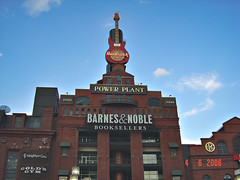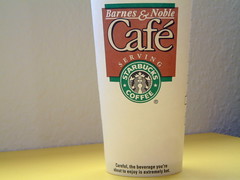
How fine is the line between socialization and social learning
Dough Johnson and Ann Krembs are here at ISB this week consulting with our school and the Library Review Committee on creating/restructuring our library learning space.
Doug wrote a great post titled: The essential question
I would highly recommend reading it and all of the comments.
The Ed Tech team and the Librarians (total 8 people) met with Doug and Ann on Thursday to get our take on the new space. At one point Doug brought up the thought about having a space for socialization versus social learning.
Just how fine is the line between socialization and social learning?
When we talk about spaces and what students’ needs are and what a school’s needs are can we blur the line between being social and social learning?
 I started thinking of my experience at the local Barnes & Nobles in my home town of Spokane, Washington and just how many times I end up there in the summer time. Sometimes I stop for a coffee at the Starbucks located inside and end up browsing books. Other times I meet friends there and just socialize, and yet other times I go there looking for books and end up drinking a coffee.
I started thinking of my experience at the local Barnes & Nobles in my home town of Spokane, Washington and just how many times I end up there in the summer time. Sometimes I stop for a coffee at the Starbucks located inside and end up browsing books. Other times I meet friends there and just socialize, and yet other times I go there looking for books and end up drinking a coffee.
B&N and Starbucks have blurred the lines between books, work, and social hour. You throw in a little WiFi connection and you’re set for the day.
Could we create spaces in our schools that were both used for socializing and at the same time a library and a place were kids go to work and get work done?
In other words…can we create the modern school?
Could a modern school library be the hangout? Do we want students to be social in a place were social learning should/could take place?
 Personally I think we need to not only blur the line but start erasing it. B&N and Starbucks do a really good job of being open in one large area but using features such as a change from tile to carpet and a little railing between the Starbucks portion and the B&N portion of the store to let people know when you have moved from one to the other. Physically they share space, but as you enter the store you can easily see where Starbucks ends and the bookstore begins.
Personally I think we need to not only blur the line but start erasing it. B&N and Starbucks do a really good job of being open in one large area but using features such as a change from tile to carpet and a little railing between the Starbucks portion and the B&N portion of the store to let people know when you have moved from one to the other. Physically they share space, but as you enter the store you can easily see where Starbucks ends and the bookstore begins.
What if we could replicate this in our libraries? What if we could create spaces that allowed students to work and be social by giving them visual ques of what is expected.
Tables and chairs that can be pushed and pulled to create group work areas.
Soft chairs among the books for casual reading.
A small area where students can buy food, drinks, snacks and just be social.
Could a library become the socialization and social learning hub of a school?
When building a space that is focused on students I would include as much as possible the students help in designing the space. What do they want? What do they need? How do they want it to flow?
Design Matters!
One thing we know with this generation is that design matters. You can have a great product, a great space, but if it isn’t designed to be “cool” kids won’t use it. Apple, Starbucks, and B&N, understand this and create products and spaces that are where students want to be. What can we learn from these companies that we can start to incorporate into our own learning/social spaces?
Space Matters!
 I love walking into any Starbucks (and I’ve been in my fair share around the world) and just looking at how they use the space. Space for a person to work by themselves on a laptop with a plugin within easy reach. A place with two or three comfy chairs and a small table for people to sit at and be social. Couches for those who need to sit next to each other. The interior is calm and soothing, the perfect volume of music playing in the background, the space that allows those to quickily come and go and not interfer with the student writing a term paper. They do such a great job with space and with traffic flow. Some day I want to design a classroom like Starbucks designs coffee shops….with the clients needs in mind!
I love walking into any Starbucks (and I’ve been in my fair share around the world) and just looking at how they use the space. Space for a person to work by themselves on a laptop with a plugin within easy reach. A place with two or three comfy chairs and a small table for people to sit at and be social. Couches for those who need to sit next to each other. The interior is calm and soothing, the perfect volume of music playing in the background, the space that allows those to quickily come and go and not interfer with the student writing a term paper. They do such a great job with space and with traffic flow. Some day I want to design a classroom like Starbucks designs coffee shops….with the clients needs in mind!
Friends and Food
Let’s get real…being a kid is all about friends and food. Students come to school because they want to be with friends not because they want to come to your class…as great as it is. At my last three schools the #1 complaint from students was always the food. They eat a lot and want good food.
What if we can build a space that meets the needs of kids today and just so happens to be embedded into a teaching and learning atmosphere where they can get work done, learn something new, and be a student, a friend, and a partner all in one space.
What if a school could embrace the social nature of students rather than fight it? Could we create a school for today’s student?







@jutecht My district usually builds 1 or 2 new schools a year. Wish we could capture this vision! http://tinyurl.com/o7fb6h
I remember being on the “design team” for a new elementary in the late 90s. The design consultant we hired had us dream and all (except the librarian) had this vision and embedded it into an open learning spaces throughout.
Once the consultant left, the Plant Manager gave us a reality check, stood up, told us how our school would model the prototypes of other schools, and scrapped weeks worth of work.
The visions are in the schools – we just need them in the eyes of the people who are given the authority to make recommendations to the Board!
Jeff, I loved this idea. If only the culture in schools allowed for your vision.
I saw a student today studying at our local New Season Grocery. He was seated in the deli eating area. He looked so at home and comfortable. Wow…what a concept.
b
It is great that Dough Johnson and Ann Krembs are putting together the findings from all constituencies in the school before making final decisions about a learning space (the library). As we guide our students toward their futures at life long learners it’s important that we not blur the lines between productive collaboration, socialization and pure distraction.
I use my own department as case in point, we have a common workroom where we find teachers planning lessons, meeting with teams, conferencing with students and doing some light grading. At times someone will make a comment or share information that we then all engage in a productive discussion that leads to learning. BUT… when we really want to grade exams, projects or papers that takes the highest level of concentration and critical thought… we seek a space without distraction.
Even in Social Learning Theory (Bandura, 1977) research shows that anything that “distracts†your attention will have a negative effect on learning. In fact, recent research at MIT and the University of Michigan shows that true multi-tasking is impossible. Though, we can prioritize and switch between two tasks we cannot do two things at once. Case in point, you know the people that annoy you by talking during the movie, they’re not watching the movie. There’s a reason why it’s often illegal to use your cell phone and drive at the same time. In addition, research shows that any detraction from attention has a negative effect on retention.
My point isn’t that we should have no social aspect to the library, but that the spaces for individual work, productive collaboration, socialization and pure distraction should have boundaries. Helping our students to understand when each space might serve a particular purpose is our job. Design is important, take the “Open Plan Schools†(classrooms without walls, etc.) created in the 60’s and 70’s—once they were in place, the first steps taken were generally to divide the common spaces and install acoustical barriers to limit the distractions.
Whatever 21st century learning is (and that is hotly debated) there is no doubt that to achieve positive outcomes, our students need to be able to concentrate. The design of the library should enhance their ability to do so.
It would be nice for us to move from the “Book museum” library that some schools seem to have and open the library up more to students to work together. Back in the olden days, when I was in school, we had the library split up into various areas, formal and informal, students could check out a conference room to work in, and EATING WAS ALLOWED in some areas. Learning took place, as with anywhere, some would abuse the privilege, and be asked to leave. The library was a comfortable place to learn and work with others, or just to hang out and talk-in the appropriate area. Some districts I have worked in, the library is only open during class hours, not before or after school. Study hall students need to have a pass from an academic teacher with a specific thing listed the student is allowed to do. Several libraries have not been welcoming places, but a place to store books.
I agree we need to make them comfortable, and have areas that are for specific activities. This is a great workable model.
Reading: "How fine is the line between socialization and social learning « The Thinking Stick" ( http://tinyurl.com/o7fb6h )
@jutecht erasing fine line btween socialization and social lrning http://twurl.nl/herpo2
would like to see public libraries think this way too! http://tinyurl.com/nwwkcb
Library spaces of the future? Thoughts? http://bit.ly/RMYkU
RT @oldslibrary Library spaces of the future? Thoughts? http://bit.ly/RMYkU
How fine is the line between socialization and social learning… http://tinyurl.com/ygge832